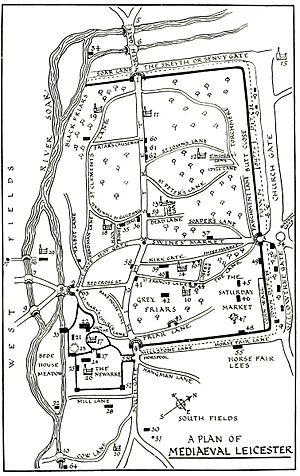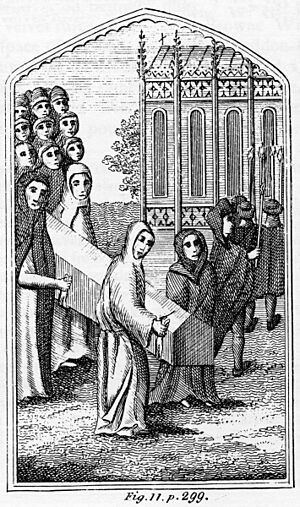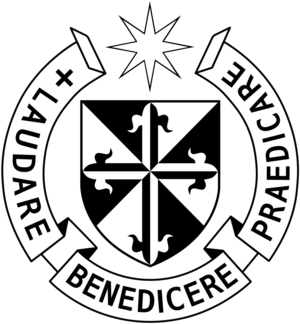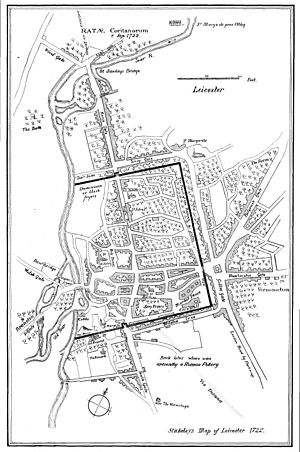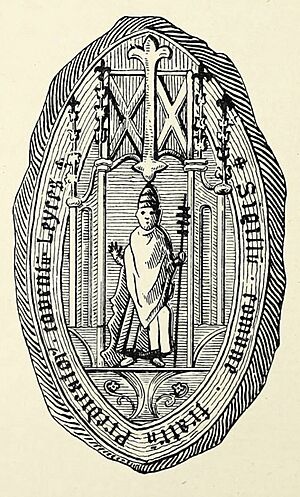Blackfriars, Leicester facts for kids
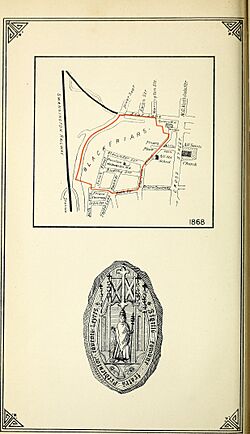
Seal of St Clement's Priory and map of the Leicester Blackfriars site
|
|
| Monastery information | |
|---|---|
| Other names | St Clement's Priory, Leicester, Leicester Dominicans, ’Le Blak Frears in le Ashes’ |
| Order | Dominican Order |
| Established | 13th century (Probably 1247-1254) |
| Disestablished | 10 November 1538 |
| Dedicated to | St Clement |
| Diocese | Lincoln |
| People | |
| Founder(s) | Simon de Montfort |
| Site | |
| Coordinates | 52°38′13″N 1°08′40″W / 52.63695°N 1.144386°W |
| Visible remains | None |
Blackfriars Leicester was once a priory (a type of monastery) for a group of monks called the Dominican Friars. They were also known as the Black Friars because of the colour of their robes. This priory was located in Leicester, England. Today, "Blackfriars" also refers to a neighbourhood in the city, built where the old priory once stood.
Contents
What was Leicester like in Roman Times?
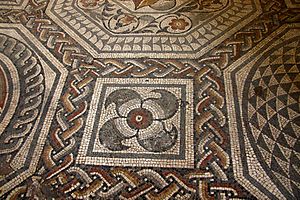
The Blackfriars Priory was built inside the old city walls of a Roman town called Ratae Corieltauvorum. This Roman town is now modern-day Leicester. The priory site was a short walk north of the Jewry Wall, which is an old Roman bathhouse wall that you can still see today.
Archaeologists found amazing Roman mosaics, called the Blackfriars Pavements, on the priory site. These mosaics show that a very rich Roman house, known as the Blackfriars Villa, once stood there.
The Story of St Clement's Church
St Clement's was one of seven very old parish churches in Medieval Leicester. In the mid-1200s, the right to run the church (called its advowson) was given to the Dominican Friars. They built their priory buildings next to it, and St Clement's became their priory church.
Like some other old churches in Leicester, there are no parts of St Clement's Church visible above ground today.
In 2018, the remains of what was likely St Clement's Church were found under what is now All Saints Road. Many burials found there date back to between 1000 and 1100. This suggests that a burial site, and possibly a church, existed there from at least the 11th century.
St Clement's: An Ancient Parish Church
This church was dedicated to St Clement of Rome, an early Pope and Christian martyr. Its exact origins are unknown, but it existed by the 11th century. It stood in the northwest part of the old Roman city.
In 1107, the right to run the church was given to the canons of St Mary de Castro. Later, in 1143, Leicester Abbey took control of St Mary's and its possessions, including St Clement's.
Before 1250, the southern part of St Clement's parish was home to Leicester's Jewish community. This area became known as Leicester's Jewry, which is why the nearby Jewry Wall has its name.
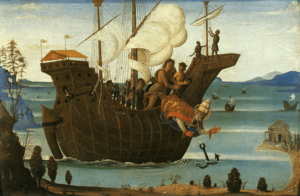
A large burial ground from the 11th century was found near the church in 2018. It contained 456 burials, with 254 in mass graves. These mass graves date to the 11th century, long before the Black Death. It's thought that these 254 people might have been victims of a famine in 1087, which was recorded in the Anglo Saxon Chronicle. Interestingly, 96 pairs of skeletons were found in double graves, suggesting the site was used for married couples.
In 1173, Robert Blanchemains, the 3rd Earl of Leicester, led a rebellion. During the Siege of Leicester that year, many homes in the parish were destroyed. St Clement's parish was probably the most affected, and the church itself likely suffered damage.
By the 1220s, the parish of St Clement's was struggling financially. This might have been because of undeveloped areas, many burials, or the impact of the 1173 siege. It became difficult for the abbey to afford a priest for the church.
How St Clement's Changed with the Dominicans
When the Dominican priory took over St Clement's, the church changed. It became known for its beautiful choral services, with a much larger choir than a typical parish church. Townspeople could attend and watch the services through a screen.
The church also used a different style of worship. Most churches in Leicester followed the Sarum Rite, but St Clement's used the Dominican Rite. This meant the masses and prayers were celebrated in a unique way, and the church also celebrated a slightly different calendar of saints.
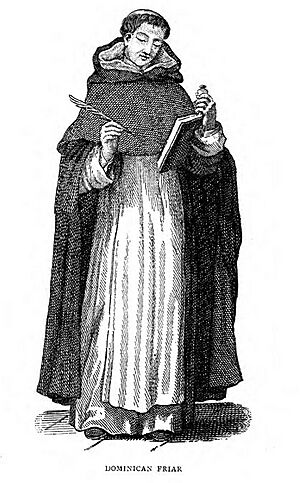
It's believed that the area where the priory stood, including the old parish, did not fall under the usual church rules of the Church of England until the late 1800s. The old parish boundaries from 1538 were never redrawn.
By the time of the Reformation (when King Henry VIII changed the church in England), St Clement's had many burials and beautiful decorations. In 1331, a man named Philip Danet wanted to set up a chantry (a special fund for prayers for his soul) in the church.
In 1536, before the priory was closed and the church torn down, a historian named John Leland visited. He wrote about seeing tombs in the church, including one for Lady Isabel and another for a knight. These few lines are the only surviving description of the building. The church was demolished soon after the priory was closed.
St Clement's Priory (Blackfriars)
The Rise of the Friars
The 1200s were a time of big changes for religious life in Europe. Many new religious groups were formed, including traveling monks called mendicant friars. In Leicester, three new religious houses were established:
- The Order of Friars Minor (Greyfriars) at the Friary of St. Mary Magdalene (before 1230).
- The Order of Hermits of St. Augustine (Austin Friars) at St. Katherine's Priory (1254).
- The Order of Preachers (Blackfriars) at St. Clement's Church (mid-1200s).
These new orders wanted to bring religious teachings and care closer to people in towns. They offered spiritual guidance, education, medical help, and pastoral care to the growing city populations.
The Blackfriars, also known as Friars Preachers, focused on prayer, learning, teaching, and preaching. They were experts in philosophy, theology, and Bible studies. They also did a lot of charity work in cities. Their main goal was to share the teachings of the Catholic Church. Two of their mottos explain their mission: "To contemplate and to pass the fruits of contemplation to others," and "To Praise, To Bless, and To Preach."
The Dominican Order had a special connection with the Earls of Leicester even before the priory was founded. St Dominic, the founder of the Dominicans, met Simon, the 5th Earl, around 1209. Simon de Montfort was fighting against a group called the Cathars, and Dominic was preaching against them. The Earl believed in Dominic's prayers and had his daughter baptized by the saint. It's likely that the Earl's son, the famous Simon de Montfort, also met Dominic during these campaigns.
How the Priory Was Founded
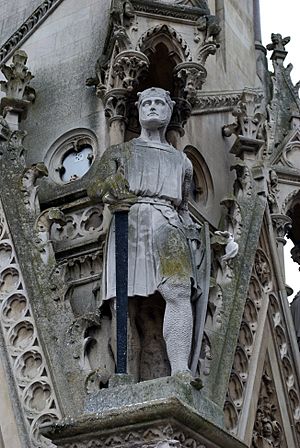
It's hard to know the exact date when the first friars arrived in Leicester or when their priory at St Clement's was officially started. The Dominican Order came to England in 1221. Some records suggest they arrived in Leicester before 1233 or in 1247. The priory was likely established before 1252.
It is almost certain that Simon de Montfort founded the priory. He gave them land from the castle, which only he could do. His involvement also explains why Leicester Abbey granted the Dominicans the right to St Clement's Church.
The priory was built in the mostly empty St Clement's parish. It included the parish church, its churchyard to the north, and land to the south for the cloister and other buildings. Over time, more land was added, making the site 16 acres.
Today, this area is between Soar Lane to the north, Great Central Street to the east, Holy Bones to the south, and the river Soar to the west. Jarvis Street runs through what was once the priory grounds. The names Blackfriars Street and Friars Causeway also remind us of the priory's presence.
Like all Dominican communities, the friars followed the Rule of St Augustine. They were led by a Prior, who was chosen by the community. The Leicester priory was overseen by the Oxford Blackfriars Priory.
Priory History
Queen Eleanor, wife of King Henry III, left £5 to the priory in her will. In 1301, the priory received another gift from the king: seven oak trees from Rockingham Forest. Other royal gifts show that in 1328/29, there were 30 friars, and in 1334/35, there were 32.
Leicester hosted important meetings for the English Dominican Province in 1301, 1317, and 1334.
In 1489, King Henry VII gave oak trees to the priory to rebuild the friars' dormitory (sleeping area).
The End of the Priory
The priory was closed down as part of King Henry VIII's dissolution of the monasteries (when he closed many religious houses). It was surrendered in November 1538. At that time, there were a prior and nine friars living there. The former priory was given to Henry Grey, 1st Duke of Suffolk, in 1546.
Today, no visible remains of the priory can be seen.
Dominicans Return to Leicester
The Dominican Friars returned to Leicester in 1819, after more than 280 years away. In 1882, they started a new priory called The Priory of the Holy Cross on New Walk, south of the old city walls. As of 2024, they are still active in the city.
Images for kids
-
A fourth Blackfriars Pavement (uncovered in 1832) in a reconstructed Blackfriars Villa in Jewry Wall Museum
-
The fourth Blackfriars Pavement in Jewry Wall Museum
-
The Holy Cross Priory, the new Dominican House in Leicester (on New Walk).
-
A Contemporary “Blackfriar” (Dominican Friar or Friar Preacher) celebrating mass in the Lady Chapel of the new Priory (Image taken in 2014).


